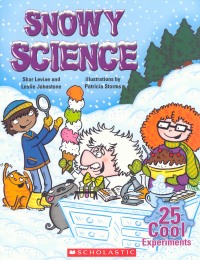| ________________
CM . . . . Volume XVIII Number 11 . . . . November 11, 2011
excerpt:
In the October 1, 2010 edition of CM (Vol. XV11, No. 5), I reviewed Scary Science: 25 Creepy Experiments, by Shar Levine and Leslie Johnstone. This year, Levine and Johnstone are back with a new Scholastic Canada publication titled Snowy Science: 25 Cool Experiments. As the excerpt above makes clear, the 25 experiments focus on more than falling snow and snow on the ground. In addition to causing frost to form on a metal container, making a model glacier, and studying glacier and snowpack movement over surfaces that vary in slope and texture, there are experiments that help children of all ages to recognize the six-sided symmetry of snow crystals, the difference in the volume of water in light fluffy snow and heavy wet snow, and the expansion of water as it freezes to become ice. There are also experiments that help in developing a more scientific understanding of wind chill, insulation, friction, and the use of salt on icy streets and highways. Unfortunately, many of these experiments are variations of experiments and investigations science teachers may have seen elsewhere. Given the track record of Levine and Johnstone, this was rather disappointing.
The presentation of the experiments follows the format established in Scary Science. Each experiment is generally described in two pages and begins with a title followed by a paragraph that places an experiment in context. The materials necessary for carrying out the experiment are then listed under the heading “You Will Need”. If there is a safety concern associated with a particular item in this bulleted list, the authors include a “Note” in bold font that advises parental supervision (e.g., while using rubbing alcohol) or cautions conducting an experiment with younger children who may be tempted to taste the material created (e.g., the putty made of Borax, glue, and water). After the materials list is the section “What To Do” that lists the steps to be followed in carrying out the experiment. An explanation of the outcome of the experiment is then provided in the “What Happened?” section. This is a component in Levine and Johnstone’s books that enables experimenters to think scientifically about the observed results and to link this understanding to events in the natural world. Rather than curtailing wonder, as some might believe, these descriptions can actually enhance a child’s curiosity and generate additional questions. Readers will also find at the end of 11 of the 25 experiments a small section with the heading “Did You Know?” that is distinguished by its blue background. The information provided in this section usually links the content of the experiment to contemporary scientific research. As one example, in carrying out the “Cutting Ice” experiment, children use a fine copper wire weighted at both ends to cut through a block of ice. It is the pressure on the ice that causes the ice to melt and cut into the block. Levine and Johnstone compare the wire to the pressure of the blade of an ice skate on ice. Scientists once believed that this pressure caused the ice to melt so that the blade of the skate glided along a thin layer of water. More recent research, however, shows that ice surfaces actually “have a thin water-like layer of molecules that allow skates (and pucks) to slide easily along the surface” (p. 37). Recommended. Barbara McMillan is a teacher educator and a professor of science education in the Faculty of Education, the University of Manitoba.
To comment
on this title or this review, send mail to cm@umanitoba.ca.
Copyright © the Manitoba Library Association. Reproduction for personal
use is permitted only if this copyright notice is maintained. Any
other reproduction is prohibited without permission.
NEXT REVIEW |
TABLE OF CONTENTS FOR THIS ISSUE
- November 11, 2011.
AUTHORS |
TITLES |
MEDIA REVIEWS |
PROFILES |
BACK ISSUES |
SEARCH |
CMARCHIVE |
HOME |
